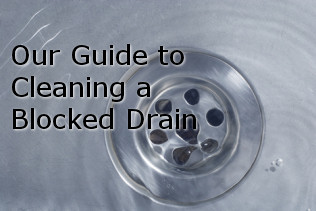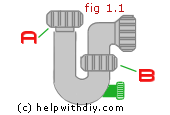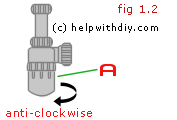How to unblock a clogged drain

Drains in the kitchen, bathroom or elsewhere inevitably get clogged up due to substantial or improper use. This page describes how to use different methods for unblocking drains.
There are preventative measures that can be taken to reduce the likelyhood of a blockage, we also look at some of these below.
A blocked drain can be more than just an inconvenience, the potential water damage can be costly, especially if not noticed immediately.
Fortunately, most blockages can be cleared simply using a plunger to free-up whatever is causing the problem. However, other types of problem may require a little bit more work to get it resolved.
There are preventative measures that can be taken to reduce the likelyhood of a blockage, we also look at some of these below.
A blocked drain can be more than just an inconvenience, the potential water damage can be costly, especially if not noticed immediately.
Fortunately, most blockages can be cleared simply using a plunger to free-up whatever is causing the problem. However, other types of problem may require a little bit more work to get it resolved.
Below we cover different methods for clearing a blocked drain, including using a plunger and clearing the waste trap under a sink. We also list some handy tips to prevent it from happening in the first place.
Please note: We will accept no responsibility for any damage or injury as a result of following this guide.
For further information please see our disclaimer, a link to which can be found at the bottom of this page.
For further information please see our disclaimer, a link to which can be found at the bottom of this page.
How to use a plunger - Using a plunger
Advertisements
For light clogging a plunger (available at most DIY stores) may do the trick, but it depends on the type of blockage involved.
Kitchen or Bathroom Sink/Basin
To improve the action of the plunger, before you use it, coat the edge of the plunger's cup with Vaseline (petroleum jelly). Also a few inches of water in the sink can improve suction.
Position the cup over the drain hole and firmly pump the handle up and down several times. Depending on the type of blockage it may take a few attempts to clear the clog.
If it doesn't clear see unblocking the trap below for possible solutions.
Plunging a clogged toilet pan
For toilet pans a standard plunger may suffice, but a larger plunger (can be hired) may be required.
Lower the plunger into the toilet, manipulate the plunger's handle to pump the cup firmly.
If using a standard sized plunger, try repositioning the plunger in the U-bend for best results.
If the plunger is unsuccessful you may need to use an auger.
Kitchen or Bathroom Sink/Basin
To improve the action of the plunger, before you use it, coat the edge of the plunger's cup with Vaseline (petroleum jelly). Also a few inches of water in the sink can improve suction.
Position the cup over the drain hole and firmly pump the handle up and down several times. Depending on the type of blockage it may take a few attempts to clear the clog.
If it doesn't clear see unblocking the trap below for possible solutions.
Plunging a clogged toilet pan
For toilet pans a standard plunger may suffice, but a larger plunger (can be hired) may be required.
Lower the plunger into the toilet, manipulate the plunger's handle to pump the cup firmly.
If using a standard sized plunger, try repositioning the plunger in the U-bend for best results.
If the plunger is unsuccessful you may need to use an auger.
Unblocking the trap
All sinks and basins should have some type of trap to block odours.

note: take extra care when replacing the nuts as they can cross-thread easily.


Tubular Traps
These are a common type of trap and fairly easy to maintain and clean.
Before starting, get a bowl for any excess water.
Some tubular traps have an access point (shown in green in fig 1.1) to aid cleaning. If your trap features an access point then remove the cap (by hand or wrench), then use a piece of wire or something similar to remove any lodged sediment that has built up during use.
If your trap doesn't have an access point, or you can't clear the blockage using the access point, then you will have to dismantle the trap. Tubular traps are very easy to remove.
These are a common type of trap and fairly easy to maintain and clean.
Before starting, get a bowl for any excess water.
Some tubular traps have an access point (shown in green in fig 1.1) to aid cleaning. If your trap features an access point then remove the cap (by hand or wrench), then use a piece of wire or something similar to remove any lodged sediment that has built up during use.
If your trap doesn't have an access point, or you can't clear the blockage using the access point, then you will have to dismantle the trap. Tubular traps are very easy to remove.
- Undo the top and bottom nuts (A and B in fig 1.1)
- You may be able to undo the nuts by hand (try using a cloth for grip). If not use a wrench carefully to loosen them first, then finish them off with your hand.
- Once they are completely loose, gently pull the U-bend away from the other pipes.
note: take extra care when replacing the nuts as they can cross-thread easily.

Bottle Traps
These are a very handy type of trap for cleaning and maintenance.
Before you start, get a bowl to catch any excess water.
To unblock any clogs, simply unscrew the base (A in fig 1.2) by turning it anti-clockwise.
The bottle can be cleaned easily when it has been removed.
These are a very handy type of trap for cleaning and maintenance.
Before you start, get a bowl to catch any excess water.
To unblock any clogs, simply unscrew the base (A in fig 1.2) by turning it anti-clockwise.
The bottle can be cleaned easily when it has been removed.
Preventative measures
To keep your drains and other plumbing systems in good working order there are a few simple steps you can follow.
- Always know where your mains water supply can be shut-off in case of a plumbing emergency.
- Tip a mixture of baking soda, boiling water and white vinegar into the drain every couple of weeks. This will help stop blockages forming in the first place.
- Try and avoid hair getting into the drainage system. There are sinkhole covers you can buy that prevent hair and other debris from entering the sink.
- Never empty cooking oil into the kitchen sink.
Advertisements
